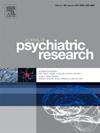Evaluation of the measurement properties of premonitory urge patient-reported outcome measure: A systematic literature review
IF 3.7
2区 医学
Q1 PSYCHIATRY
引用次数: 0
Abstract
Objective
This study aims to systematically evaluate the measurement properties of premonitory urge patient-reported outcome measures (PROMs) in patients with tic disorder using Consensus-based standards for the selection of health measurement instruments (COSMIN) methodology and provide recommendations for clinical assessment.
Method
A systematic search was conducted in PubMed, EMBASE, Web of Science, and PsycINFO, from database inception to October 9, 2022, with an additional supplementary search conducted from October 9, 2022, to January 4, 2025. After literature screening and data extraction, two independent reviewers objectively assessed the measurement properties according to COSMIN.
Results
A total of 18 studies were included, involving four PROMs: Premonitory Urge for Tics Scale (PUTS), University of São Paulo's Sensory Phenomena Scale (USP-SPS), Individualized Premonitory Urge for Tics Scale (I-PUTS), and the Rumination and Awareness Scale for tic-associated sensations (RASTS). Methodological quality and criteria were conducted for content validity, internal structure (structural validity, internal consistency), and remaining measurement properties (reliability, hypothesis testing for construct validity).
Conclusion
PUTS is recommended for assessing premonitory urge in tic disorder, which aligns with the “European Clinical Guidelines for Tourette Syndrome and other Tic disorder—version 2.0. Part I: assessment”. To assess premonitory urge and sensory modulation disorder, the USP-SPS is deemed appropriate, while the RASTS is suitable for evaluating premonitory urge and tic-related cognitions. However, USP-SPS and RASTS need further validation due to limited evidence, and their use should be considered based on specific clinical or research objectives.
先兆急症患者报告结果测量的测量特性评价:系统的文献综述
目的采用基于共识的健康测量仪器选择标准(COSMIN)方法,系统评价抽动障碍患者先兆急症患者报告结果测量(PROMs)的测量特性,并为临床评估提供建议。方法系统检索PubMed、EMBASE、Web of Science、PsycINFO数据库,检索时间为数据库建立至2022年10月9日,并补充检索时间为2022年10月9日至2025年1月4日。经文献筛选和资料提取后,由两名独立评审员根据COSMIN标准客观评价测量特性。结果共纳入18项研究,涉及4个PROMs量表:抽搐前兆冲动量表(PUTS)、圣保罗大学感觉现象量表(USP-SPS)、个例抽搐前兆冲动量表(I-PUTS)和抽搐相关感觉反刍与意识量表(RASTS)。对内容效度、内部结构(结构效度、内部一致性)和剩余测量属性(信度、结构效度的假设检验)进行方法学质量和标准评估。结论:推荐使用puts来评估抽动障碍的先兆冲动,这与“欧洲抽动综合征和其他抽动障碍临床指南- 2.0版”一致。第一部分:评估”。为了评估先兆冲动和感觉调节障碍,USP-SPS被认为是合适的,而RASTS适用于评估先兆冲动和与抽搐相关的认知。然而,由于证据有限,USP-SPS和RASTS需要进一步验证,并且应基于特定的临床或研究目标来考虑它们的使用。
本文章由计算机程序翻译,如有差异,请以英文原文为准。
求助全文
约1分钟内获得全文
求助全文
来源期刊

Journal of psychiatric research
医学-精神病学
CiteScore
7.30
自引率
2.10%
发文量
622
审稿时长
130 days
期刊介绍:
Founded in 1961 to report on the latest work in psychiatry and cognate disciplines, the Journal of Psychiatric Research is dedicated to innovative and timely studies of four important areas of research:
(1) clinical studies of all disciplines relating to psychiatric illness, as well as normal human behaviour, including biochemical, physiological, genetic, environmental, social, psychological and epidemiological factors;
(2) basic studies pertaining to psychiatry in such fields as neuropsychopharmacology, neuroendocrinology, electrophysiology, genetics, experimental psychology and epidemiology;
(3) the growing application of clinical laboratory techniques in psychiatry, including imagery and spectroscopy of the brain, molecular biology and computer sciences;
 求助内容:
求助内容: 应助结果提醒方式:
应助结果提醒方式:


